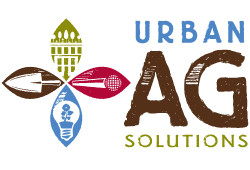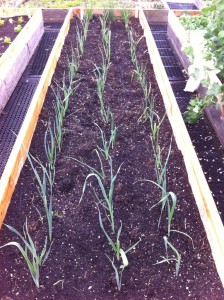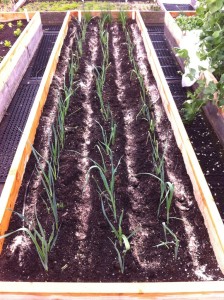Look at this photo and tell me what you see:
Yes, clearly a raised bed, and, yes, those are leeks. But there is also something else there that is crucially important to the backyard gardener: space. Do you see it now that I’ve marked it for you?
Many years ago I read a book called Drawing on the Right Side of the Brain. It’s a book about learning to sketch by “seeing” negative space, which is basically the void surrounding and possibly within an object you are trying to draw. Once you start to see the space as containing the object, you can see the shape of the space and draw that instead of the object per se. It was certainly a mind-opening perspective shift, and though I have not dedicated much time to sketching over the years, I never did forget the insight. Good thing, too, because it’s come back to help me in gardening.
At many moments in the garden, especially now in the late spring, warm-season or long-season crops are going in as small starts. They require generous spacing between them because they will grow, hopefully, to substantial size. Upon their arrival into their garden bed, however, they are disproportionately surrounded by soil: small green things in a sea of brown.
This is where having a cache of quick-growing mustard-family seeds at the ready can be a godsend. We all know what Mother Nature does to soil space…fills it with opportunistic, crazy-fast growing plants we call “weeds”. As you learn to see the negative space surrounding your plant as positive growing potential, you become Mother Nature’s helper and select the “weed” for the space, in this case a crazy-fast growing mustard. Say you throw down a carpet of arugula or ruby streaks mustard seed around a tomato start. In 21 days or so, at least within the month, you’ll be harvesting a great addition to your lettuce-patch salads, and that even before your tomato knows it had any competition. When that tomato, or eggplant, or squash, or whatever has finally settled in to its new home and seriously begins to grow, you’ve already gotten your crop of greens and can now give the space-loving crop its due.
In an ornamental garden, the object may be to highlight a particular plant’s foliage by offsetting it against the soil or a mulch. Or it may be a featured focal point and thus command the surrounding space from the start. But in my book the veggie garden is about productivity, and that means a constantly-renewing, horizontal sea of salad greens and herbs punctuated by the trellised peas or toms or the periodic blob of squash leaves. In a limited garden, space is waste. Space not, waste not, want not.


